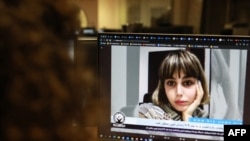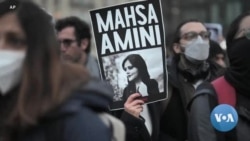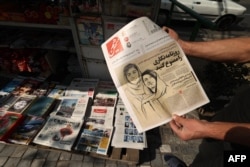Three months into Iran's crackdown on coverage of widespread protests, media analysts remain troubled by the dozens of journalist arrests and reports of abuse in detention centers.
"Right now is probably the worst time to ever be a journalist in Iran," said Sherif Mansour, Middle East and North Africa program coordinator for the Committee to Protect Journalists (CPJ).
Data released by CPJ in December showed Iran as the top jailer of journalists globally, with 62 reporters — 24 of whom are women — currently in prison.
More than 20 other journalists have been arrested since September, but released on bail.
The numbers are the highest on record in the 30 years since the New York-based nonprofit began tracking arrests there.
Nearly all those detained were arrested in connection to their coverage of protests that began in September, following the death of Mahsa Amini, a 22-year-old Kurdish woman who died while in state custody. Thousands of protesters are also being held.
Some face charges that could result in a death penalty. Iran earlier in December executed two protesters.
In the past, groups like the CPJ and Coalition For Women In Journalism (CFWIJ) have been able to evacuate journalists in danger, but travel bans and closed borders have made that impossible.
"There is no way out," said Mansour.
Iran's Mission at the U.N. did not respond to VOA's request for comment.
Protest crackdown
CPJ and other watchdogs documenting arrests found that more than 20 of the journalists imprisoned over protest coverage are women.
By comparison, after the 2009 protests over a disputed presidential election, only four of the 47 journalists arrested were women.
The higher number in 2022 hints at the "role women are playing" in the protests, according to Mansour.
The rallies have been women-led, advocating not just an end to compulsory hijab, but an end to policies by the Iranian regime that have restricted women's rights in Iran since 1979.
But while the arrests are linked to protest coverage, Mansour points out that authorities in many cases detained the journalists at their homes.
"The majority of them were arrested violently in front of their families and neighbors, which shows that the government knew where they lived," said Mansour.
CPJ's research has found instances of journalists held in solitary confinement for weeks at a time, detained in overcrowded cells or denied access to medical care.
Others have been forced to appear on camera and "confess to crimes they never committed" including espionage, anti-state charges, and moharebeh — enmity against God, Mansour told VOA.
But with access to internet and social media restricted, and government surveillance high, working to verify cases can be hard.
Media watchdogs, including CPJ, speak with journalists, lawyers and human rights activists inside the country to gather and verify information.
The accounts they hear are disturbing.
While both men and women have faced abuse, female journalists are subjected to additional "gendered violations," according to Kiran Nazish, founding director of CFWIJ.
The organization, which works with women and LGBTQ journalists globally, has seen a similar pattern in other countries.
"We have been told by journalists and lawyers, that in some instances police or prison guards have indulged in straightforward sexual acts, including touching their genitalia," Nazish told VOA via email. "We don't see male journalists treated in the same way."
Iran's prison service in early December denied any women are sexually assaulted while detained, Agence France-Presse reported.
Minorities under pressure
Also targeted by authorities in recent months are Kurdish journalists, according to both CFWIJ and CPJ. Nine of those currently detained in Iran are Kurdish.
"The retaliation by the IRGC, the Islamic Revolutionary Guard Corps, in Kurdish areas was a lot more militarized" than in other cities, Mansour said, adding that curfews were put in place.
Kurdish women journalists have been "intimidated more openly," and arrests without warrants are also more common in Kurdish areas, said Nazish.
"The most vulnerable women in the media come from remote areas and smaller cities," she told VOA, adding that those individuals often lacked support or resources at national or international levels.
"Authorities and governments know this very well, and hence we see a greater number of smear campaigns, legal harassment and arrests in the smallest cities," she said.
Tehran's response to protests and unrest extends beyond media.
The Human Rights Activists News Agency (HRANA), a non-governmental organization that monitors human rights violations in Iran, estimates more than 18,000 people have been arrested since protests broke out.
Trials involved an "extremely quick and non-transparent judicial process" where those charged were denied access to chosen lawyers, HRANA has reported.
"The lack of due process should be condemned in the strongest terms," Skylar Thompson, senior advocacy coordinator for HRANA, told VOA via email. "The arbitrary approach of the judiciary is of absolute alarm — we are facing a system that is not even following its own laws. This is happening systemically and, in some instances, appeals are not being allowed."
Iran executed two protesters — Mohsen Shekari and Majidreza Rahnavard — who were convicted of moharebeh after allegedly injuring and killing paramilitary volunteers. Rahnavard was hanged from a construction crane in front of a crowd of people.
At least 58 others in detention have either been sentenced to death or are "at risk of receiving a death sentence," according to HRANA.
All journalists who have been arrested, including those released on bail, "could be subjected to the same politically motivated trials," Mansour told VOA.
Despite the risks, many journalists in Iran continue to cover protests and connect with sources on the ground.
"Lack of ... accurate information on Iran can critically impact some big issues, including foreign policy of our governments toward Iran to any actions by the U.N. that can be taken to support Iranians calling for justice," Nazish told VOA.
"Media and free media is the thread that connects our global reality to intricate stories and lives in Iran," Nazish said. "This is why many of the women journalists we speak to repeatedly say something along the lines of, 'journalism is not a job, it's a duty.'"













